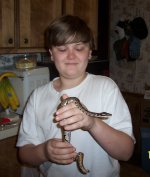2i2_D3gr33s
I AM A:
I just seen about a dozen baby ball pythons, and they seemed to be much calmer than some of my corns. I was thinking that this may be a good option for my daughter (who's five) who loves snakes, but doesn't handle my corns too much, just because they're so quick, and if she'd ever drop one, it would be gone. So, I was just wondering if any owners of ball pythons could give me some tips on balls, or point me in the direction of a good forum or book that I should pick up before I buy one. Thanks guys.

